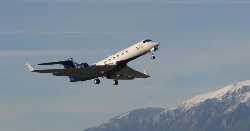AIRCREW SAFETY & HEALTH

Photo courtesy of Julie Haggerty (NCAR)
Noise/Hearing Loss
What you need to know
Occupational hearing loss is one of the most common work-related injuries in the United States. There are many sources of noise during flight operations. Here you can learn more about how aircrew can lower exposure to aircraft noise.
What are sources of aircraft noise?
- On the ground, aircraft engines, takeoff preparations, and braking are sources of noise on aircraft.
- When airborne, the aircraft engines and high speed turbulence over the fuselage are the largest sources of noise on aircraft. Announcements and mechanical noises from food and beverage service are other sources of noise.
- NIOSH conducted noise surveys in 2002 and 2003 on regional jets and turboprop aircraft. Noise levels were generally lower than NIOSH and/or OSHA recommended or regulated exposure levels, but some measurements briefly approached or surpassed these levels. Hearing protection, especially during takeoff and landing, is one option for reducing these exposures.
- A study of noise on Airbus A321 aircraft reported levels of 60-65 decibels (dBA) before takeoff; 80-85 dBA during flight; and 75-80 dBA during landing. The outside of aircraft engines (around 140 dB at takeoff) and conditions on other aircraft may have higher or lower noise levels. Sound insulation also varies among aircraft.
What are the recommended levels for noise at work?
- We recommend that all worker exposures to noise be controlled below a level equivalent to 85 dBA for eight hours to minimize occupational noise induced hearing loss.
- We also recommend a 3 dBA exchange rate so that every increase by 3 dBA doubles the amount of the noise and halves the recommended amount of exposure time.
What is not known
- Hearing loss accumulates over a lifetime. If you are exposed to aircraft noise and have health problems, we can’t tell if it was caused by your work conditions or if it was caused by something else.
- Although we know general ranges of noise levels on aircraft, noise levels have not been measured on all aircraft and can vary.
What you can do to reduce exposure to noise on aircraft
- Wear hearing protection during take-off and landing.
- The Airbus A321 study suggests that noise levels are higher in the rear of the cabin, near and behind the engines and propellers, and near windows. When you have a choice, moving to other locations in the cabin may reduce your noise levels.
- Learn more about protecting your hearing from the NIOSH Noise and Hearing Loss Prevention Website.
- Follow up with your doctor if you have concerns about your noise exposures. Make sure your doctor knows that you work as a crewmember. Sharing this and other information with your doctor may be useful. You or your doctor may also contact us for more information.
For more information
- NIOSH Health Hazard Evaluations of Aircraft:
- Journal of the Canadian Acoustical Association: In-cabin noise levels during commercial aircraft flights
- If you have safety and health questions about your job contact us
- Page last reviewed: May 9, 2017
- Page last updated: May 9, 2017
- Content source:
- National Institute for Occupational Safety and Health Division of Surveillance, Hazard Evaluations and Field Studies


 ShareCompartir
ShareCompartir